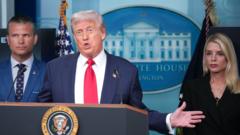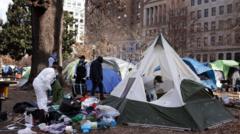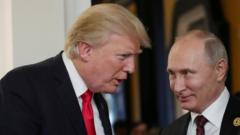As discussions surrounding crime in Washington DC intensify, former President Trump asserts that the city faces a crime emergency, while Mayor Muriel Bowser highlights a significant decline in violent crime. This article explores crime statistics and contrasting narratives, revealing complexities within the debate.
Evaluating Crime Rates in Washington DC: A Deep Dive into the Claims and Data

Evaluating Crime Rates in Washington DC: A Deep Dive into the Claims and Data
A look into the current crime statistics in Washington DC amid contrasting claims by former President Donald Trump and local leaders regarding rising violence and safety measures.
Former President Donald Trump has characterized crime rates in Washington DC as spiraling out of control, announcing plans to deploy National Guard troops and assert federal control over the local police to combat what he termed "crime, bloodshed, bedlam, and squalor." However, DC Mayor Muriel Bowser counters this assertion, stating the city is experiencing a robust decline in crime, with violent offenses hitting a 30-year low, according to recent data from the Metropolitan Police Department (MPDC).
Trump's executive order cites a "rising violence" crisis in the capital, leading him to proclaim an emergency. Yet, statistics from the MPDC indicate a sharp decline in violent crime, which has dropped by 26% this year compared to last, with a 28% decrease in robbery. The FBI's crime data presents slightly different figures, reflecting a 9% drop, but both sources confirm a downward trajectory of violent crime in the city.
Experts suggest that while there is a consistent decline in crime, the variances in reporting methods can lead to differing representations of the situation. Adam Gelb, CEO of the Council on Criminal Justice (CCJ), pointed out that while crime reporting varies by time and category, a significant overall reduction in violence is apparent since the summer of 2023, when crime rates spiked.
Trump also addressed concerns over murder rates, claiming that 2023 recorded unprecedented homicide levels in DC, referencing figures provided by the FBI. Although the homicide rate did rise in 2023—to around 40 per 100,000 residents—historically it was higher in the 1990s and early 2000s. Recent MPDC data for 2024 shows a decline of 12% in homicides compared to the previous year.
In discussing carjackings, Trump asserted that such incidents have tripled over the last five years. However, current statistics reveal that carjackings have actually decreased from 300 reported incidents in the same period last year to 189 so far this year. A citywide curfew implemented to curb juvenile crime, especially carjackings, has also been a recent strategy employed by local authorities.
When comparing Washington DC's crime rates to other large US cities, experts acknowledge that while violence levels remain elevated, the declining trend aligns with national patterns. The CCJ reported a 19% decrease in homicides in the first half of 2025 compared to the same period in 2024, slightly above the 17% average reduction across major cities in the study. However, the comparison to pre-pandemic levels shows only a minimal 3% drop in homicides.
The debate continues as citizens and leaders navigate these contrasting narratives on crime in Washington DC—one side emphasizing the gravity of the situation and the other celebrating strides toward improved safety and reduced violence.



















